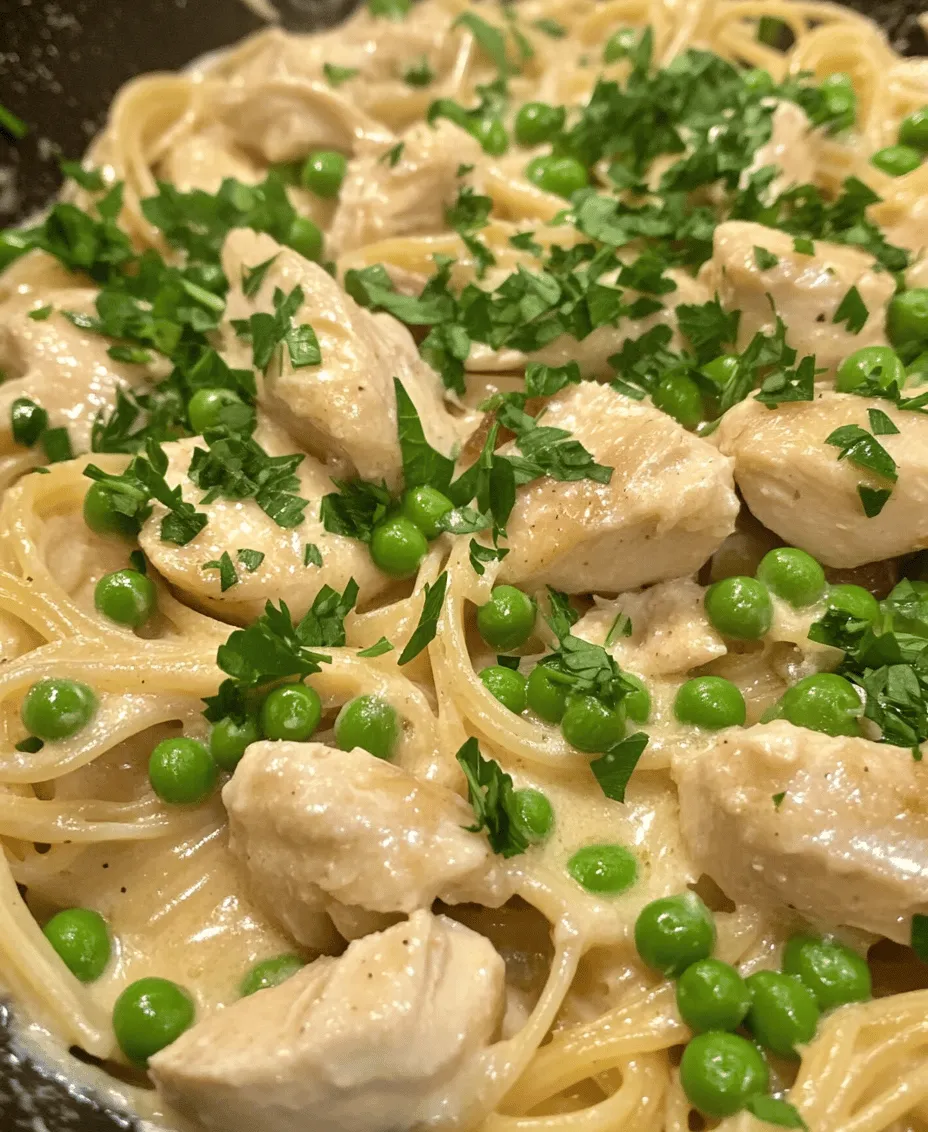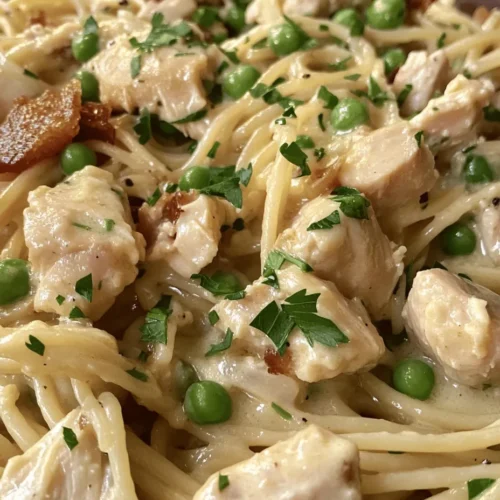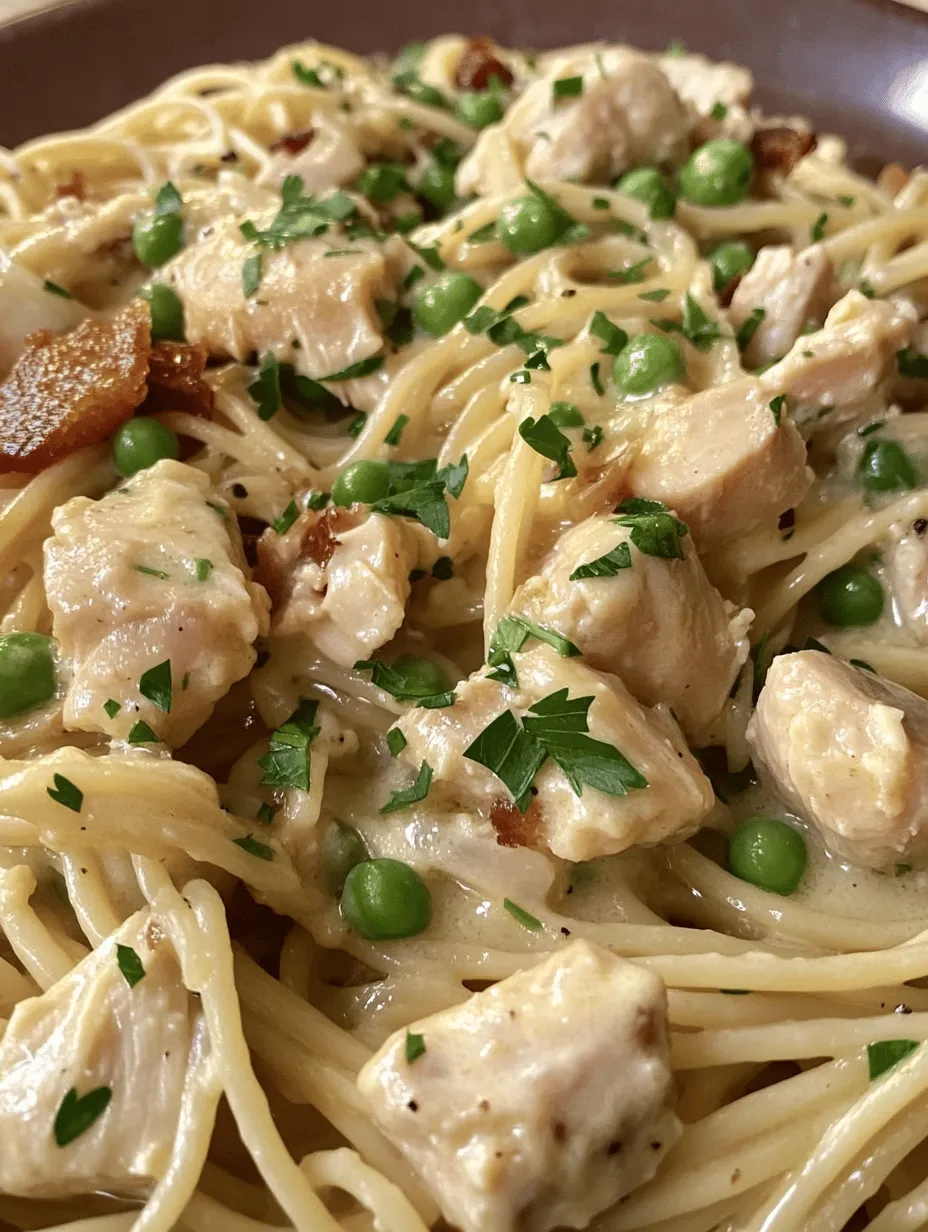Introduction: The Allure of Chicken Carbonara
When it comes to comfort food, few dishes can rival the richness and satisfaction of Chicken Carbonara. This delightful twist on the classic Italian recipe combines tender pieces of chicken, crispy pancetta, and a creamy sauce that clings to every strand of pasta. Each bite is a celebration of flavors and textures, making it a favorite for family dinners and special occasions alike. In this article, we will explore the origins of Carbonara, the key ingredients that make this dish shine, and provide you with a step-by-step guide to creating the best-ever Chicken Carbonara right in your own kitchen.
Understanding the Origins of Carbonara
The Italian Roots of Carbonara
Carbonara is a dish with a rich history, believed to have originated in the Lazio region of Italy, particularly in Rome. The dish is said to have been created by Italian charcoal workers, known as “carbonari,” who would prepare their meals using easily transportable ingredients that could be cooked over an open flame. Traditional Carbonara is made with spaghetti, guanciale (cured pork cheek), eggs, cheese, and black pepper. This simple yet flavorful combination became a staple in Roman cuisine, celebrated for its creamy texture and savory depth.
Over the years, Carbonara has evolved, adapting to regional tastes and available ingredients. Variations have emerged worldwide, with some cooks substituting different types of pasta or adding vegetables. However, the essence of Carbonara remains the same: a creamy sauce created through the magic of fresh eggs and cheese, coating the pasta in a comforting embrace.
Key Ingredients and Their Importance
To create the best-ever Chicken Carbonara, understanding the role of each ingredient is crucial. Here’s a breakdown of the essential components that elevate this dish to new heights:
1. Spaghetti: The heart of Chicken Carbonara is the pasta. Spaghetti is the most common choice, as its long strands hold onto the sauce beautifully. Choosing the right type of pasta is essential for achieving that classic Carbonara experience.
2. Chicken: Boneless, skinless chicken breasts provide a tender and juicy protein that complements the richness of the sauce. The chicken is often sautéed until golden brown, adding a lovely depth of flavor.
3. Pancetta vs. Bacon: While traditional Carbonara uses guanciale, many recipes opt for pancetta or even bacon due to their availability. Pancetta is a cured pork that offers a rich, savory flavor without being overpowering. Its crispy texture adds a delightful crunch to the dish.
4. Dairy: Heavy cream and Parmesan cheese are essential for achieving that velvety, creamy sauce. The cream adds richness, while the Parmesan contributes a sharp, nutty flavor, enhancing the overall taste of the dish.
5. Garlic and Peas: Garlic is a common flavor enhancer in many pasta dishes, and its aromatic qualities bring a wonderful depth to Chicken Carbonara. Adding peas not only adds a pop of color but also a touch of sweetness that balances the savory notes of the pancetta and cheese.
Gathering Your Ingredients: What You Need for Best-Ever Chicken Carbonara
Essential Ingredients List
To make Chicken Carbonara, you’ll need the following ingredients:
– Spaghetti: 12 ounces (or your preferred pasta)
– Boneless, Skinless Chicken Breasts: 2 medium-sized, diced
– Pancetta: 4 ounces, diced (you may substitute with bacon if necessary)
– Heavy Cream: 1 cup
– Parmesan Cheese: 1 cup, freshly grated
– Garlic: 2 cloves, minced
– Frozen Peas: 1 cup (fresh can also be used)
– Olive Oil: 2 tablespoons
– Salt and Pepper: to taste
– Fresh Parsley: for garnish (optional)
Choosing the Right Type of Pasta
When selecting spaghetti for your Chicken Carbonara, opt for high-quality pasta made from durum wheat. This type of pasta has a firm texture and can hold up well to the creamy sauce. Additionally, look for pasta that has a rough surface, as this will help the sauce cling better. Cooking the pasta to al dente is key, as it will continue to cook slightly when mixed with the sauce.
The Importance of Boneless, Skinless Chicken Breasts
Choosing boneless, skinless chicken breasts is essential for this recipe. They cook quickly and are easy to cut into bite-sized pieces. The absence of skin allows for a lighter dish, letting the flavors of the Carbonara shine through. For added flavor, consider marinating the chicken in olive oil, garlic, and a pinch of salt and pepper before cooking.
Pancetta vs. Bacon: Flavor Differences
While pancetta is the traditional choice for Carbonara, bacon can be a suitable substitute if pancetta is unavailable. However, it’s essential to note that pancetta has a milder flavor compared to bacon, which tends to be smokier. If using bacon, consider reducing the amount or pairing it with a touch of extra Parmesan to balance the flavors.
The Role of Heavy Cream and Parmesan Cheese
Heavy cream is the secret to achieving that luscious, creamy sauce that Carbonara is famous for. It adds richness and helps create a silky texture when combined with the cheese. Freshly grated Parmesan cheese is preferred, as it melts beautifully and provides a robust flavor. Avoid pre-grated cheese, which often contains anti-caking agents that can affect the sauce’s consistency.
Garlic and Peas: Adding Depth and Color
Garlic is a staple in many Italian dishes, and for good reason. Its aromatic qualities enhance the flavor profile of Chicken Carbonara. Peas are not only visually appealing but also provide a subtle sweetness that complements the savory elements of the dish. Their bright green color adds vibrancy to the overall presentation.
Preparing for Success: Kitchen Tools and Prep Work
Essential Kitchen Equipment
Having the right kitchen tools can make your cooking experience smoother and more enjoyable. Here’s a list of essential equipment for making Chicken Carbonara:
– Large Pot: For boiling the pasta, a large pot is necessary to provide ample space for the spaghetti to cook evenly.
– Skillet or Frying Pan: A large skillet is ideal for sautéing the chicken and pancetta, allowing for even cooking and browning.
– Colander: Used for draining the pasta once it’s cooked.
– Measuring Cups and Spoons: Accurate measurements ensure consistent results, particularly with the cream and cheese.
– Wooden Spoon or Spatula: Essential for stirring and combining ingredients without scratching your cookware.
– Grater: For freshly grating Parmesan cheese.
Preparation Steps
Before diving into the cooking process, taking the time to prepare your ingredients can significantly streamline your efforts. Here are some tips to ensure a smooth cooking experience:
1. Mise en Place: Gather and measure all your ingredients before you start cooking. This not only helps reduce stress but also ensures that you won’t forget any components during the cooking process.
2. Dice the Chicken: Cut the boneless, skinless chicken breasts into bite-sized pieces and season them lightly with salt and pepper. This allows for even cooking and enhances the overall flavor of the dish.
3. Prepare the Pancetta: Dice the pancetta into small cubes to maximize its crispiness. The smaller pieces will render fat more quickly, providing flavor to the chicken and the sauce.
4. Mince the Garlic: Preparing garlic ahead of time will help you add it to the skillet at the right moment for maximum flavor impact.
5. Grate the Parmesan Cheese: Freshly grated cheese melts better and enhances the creaminess of the sauce. Grate enough to have a cup ready for cooking and additional for serving.
6. Measure the Cream and Peas: Having these ingredients ready will allow you to combine everything seamlessly without scrambling to measure mid-cooking.
Step-by-Step Guide to Making Chicken Carbonara
Cooking the Pasta to Perfection
Cooking the pasta correctly is crucial to achieving the ideal Chicken Carbonara. Follow these steps to ensure your spaghetti is perfect:
1. Boil the Water: Fill a large pot with water and bring it to a rolling boil. Add a generous amount of salt—this is your chance to flavor the pasta. A good rule of thumb is 1 tablespoon of salt for every 4-6 quarts of water.
2. Cook the Spaghetti: Add the spaghetti to the boiling water and cook according to the package instructions, usually around 8-10 minutes, until al dente. This means the pasta should be firm to the bite but not hard.
3. Reserve Pasta Water: Before draining the pasta, save about a cup of the starchy cooking water. This liquid is essential for adjusting the sauce’s consistency later on, helping it adhere to the pasta.
4. Drain the Pasta: Use a colander to drain the spaghetti, shaking off any excess water. Do not rinse the pasta, as you want the starch to cling to the noodles, aiding in the sauce’s adherence.
5. Combine with Sauce: Once the sauce is prepared, the hot pasta will help to meld the flavors together. Add the drained spaghetti to the skillet with the sauce, tossing to coat.
By following these detailed steps and understanding the significance of each ingredient, you’re well on your way to creating the best-ever Chicken Carbonara. The dish is not only a feast for the palate but also a comforting, satisfying meal that can be enjoyed by family and friends alike. Stay tuned for the next part of this article, where we will delve into the cooking process, providing you with clear, actionable steps to bring this delicious recipe to life.

Cooking the Chicken: Achieving the Perfect Texture
To create the best-ever Chicken Carbonara, the chicken must be cooked to perfection. Start by seasoning the chicken breast generously with salt and freshly cracked black pepper. This simple step enhances the chicken’s natural flavors and prepares it for the cooking process.
Techniques for Seasoning and Cooking Chicken
For optimal results, consider marinating the chicken in olive oil, garlic, and herbs for at least 30 minutes before cooking. This not only infuses the meat with flavor but also helps tenderize it. When it comes to cooking, you can either pan-sear, grill, or bake the chicken. Pan-searing in a hot skillet with a tablespoon of olive oil is particularly effective. Heat the skillet over medium-high heat until the oil shimmers, then add the chicken. Cooking time will depend on the thickness of the breast, typically around 6-8 minutes per side.
How to Ensure the Chicken Remains Juicy
To ensure that the chicken remains juicy, avoid overcooking. Use an instant-read thermometer to check the internal temperature, which should reach 165°F (75°C). Once cooked, let the chicken rest on a cutting board for at least 5 minutes. This allows the juices to redistribute, ensuring every bite remains moist and flavorful. After resting, slice the chicken into bite-sized pieces, making it easier to incorporate into the Carbonara sauce later.
Crisping the Pancetta or Bacon
The next step in achieving the rich flavor profile of Chicken Carbonara is crisping the pancetta or bacon. The choice between these two ingredients can subtly change the dish’s character. Pancetta offers a delicate flavor, while bacon provides a smoky touch.
The Ideal Cooking Time for Achieving the Right Texture
To achieve perfectly crispy pancetta or bacon, heat a large skillet over medium heat. Add the diced pancetta or bacon and cook for about 6-8 minutes, stirring occasionally. The goal is to render the fat while creating a crispy texture. The key is to avoid cooking at too high a temperature; otherwise, you risk burning the meat before the fat has rendered completely.
How the Fat Renders and Enhances Flavor
As the pancetta or bacon cooks, the fat will render out, creating a flavorful base for your Carbonara sauce. This rendered fat not only adds richness but also helps to coat the pasta later, ensuring that every strand is infused with flavor. Once crispy and golden brown, remove the pancetta or bacon from the skillet and set it aside on a plate lined with paper towels to absorb excess grease.
Creating the Creamy Sauce
Now we delve into one of the most essential parts of Chicken Carbonara—the creamy sauce. This sauce is what truly elevates the dish, providing that classic Carbonara texture and flavor.
Whisking Eggs and Cream: Achieving the Right Consistency
In a mixing bowl, whisk together the eggs, heavy cream, and freshly grated Parmesan cheese. Aim for a smooth, creamy consistency. The ratio of eggs to cream can vary based on personal preference; typically, using two large eggs combined with ½ cup of cream is ideal for maintaining that rich flavor without being overly heavy. For an extra layer of flavor, consider adding a pinch of nutmeg or a dash of garlic powder to the mixture.
Importance of Timing When Adding the Sauce to the Pasta
Timing is crucial when it comes to adding the sauce to the pasta. Once the pasta is cooked al dente, reserve about ½ cup of pasta cooking water before draining. This starchy water is essential for adjusting the consistency of the sauce later. After draining, immediately add the hot pasta to the skillet with the pancetta or bacon. This residual heat will help cook the egg mixture without scrambling it. Quickly pour the cream and egg mixture over the pasta, tossing continuously to ensure an even coating.
Bringing It All Together
Combining the ingredients of your Chicken Carbonara requires finesse to avoid overcooking the sauce.
Techniques for Combining Ingredients Without Overcooking
As you toss the pasta with the sauce, be mindful of the heat. If necessary, remove the skillet from the burner to prevent the eggs from scrambling. The goal is to create a silky, creamy sauce that clings to each strand of pasta. If the sauce is too thick, gradually add the reserved pasta water until you reach your desired consistency.
The Magic of Residual Heat in Cooking the Sauce
The heat from the freshly cooked pasta is what will cook the eggs gently, transforming them into a creamy sauce. This technique is the hallmark of Carbonara, ensuring that the sauce is rich without being overly dense. The result should be a luxurious coating that envelops the pasta, with the crispy pancetta or bacon interspersed throughout.
The Final Touches: Serving Your Chicken Carbonara
With your Chicken Carbonara beautifully combined, it’s time to plate and present this delicious dish.
Plating and Presentation
For an appealing presentation, twirl the pasta onto a serving plate using a fork or tongs. This creates a visually striking focal point that entices the appetite. Consider using a shallow bowl or a wide plate to showcase the creamy sauce and chicken pieces.
Garnishing with Parsley and Extra Parmesan Cheese
Finish off your dish with a sprinkle of freshly chopped parsley for a pop of color and freshness. Additionally, a generous grating of extra Parmesan cheese enhances both flavor and presentation, inviting guests to dig in.
Pairing Suggestions
To complement your Chicken Carbonara, consider serving it with a simple green salad dressed lightly with lemon vinaigrette. The acidity of the dressing balances the richness of the dish.
Recommended Side Dishes to Complement the Meal
Garlic bread or crusty Italian bread is another excellent choice, perfect for soaking up the creamy sauce. Roasted vegetables, like asparagus or Brussels sprouts, add a nutritious touch and bring a satisfying crunch.
Beverage Pairings That Enhance the Flavors of Chicken Carbonara
When it comes to beverages, a chilled white wine, such as Pinot Grigio or Chardonnay, pairs beautifully with Chicken Carbonara. The crispness of the wine complements the dish’s richness, creating a harmonious dining experience.
Nutritional Insights: Understanding the Calories and Health Aspects
As with any indulgent dish, understanding the nutritional breakdown of Chicken Carbonara can help you enjoy it mindfully.
Nutritional Breakdown of Chicken Carbonara
A typical serving of Chicken Carbonara contains approximately 600-700 calories, depending on portion size and specific ingredients used. The macronutrient profile is generally as follows:
– Proteins: Approximately 30-35 grams from chicken and cheese.
– Fats: Around 30-40 grams, primarily from cream and pancetta or bacon.
– Carbohydrates: Roughly 60-70 grams, mainly from pasta.
Healthier Alternatives and Substitutions
If you’re looking for lighter alternatives, consider using whole grain or legume-based pasta for added fiber. You can also substitute the heavy cream with a blend of Greek yogurt and low-fat milk, which reduces the calorie count without sacrificing creaminess. For those with dietary restrictions, gluten-free pasta options are widely available and can be used seamlessly in this recipe. Dairy alternatives, such as almond or coconut cream, can be used for a dairy-free version of the sauce.
Conclusion: The Joy of Homemade Chicken Carbonara
Creating Chicken Carbonara from scratch is an incredibly satisfying culinary experience. The rich flavors meld together beautifully, offering a comforting meal that delights the senses. This dish is not just a staple of Italian cuisine; it’s a representation of love, tradition, and the joy of sharing delicious food with family and friends.
Whether you’re serving it for a casual weeknight dinner or a special occasion, Chicken Carbonara is sure to impress. The creamy sauce, tender chicken, and crunchy pancetta create a perfect balance that invites creativity in the kitchen. With its rich taste and irresistible texture, Chicken Carbonara deserves a special place on your dining table, bringing warmth and comfort to every meal. Enjoy making this classic dish and savor the joy it brings to your home.



